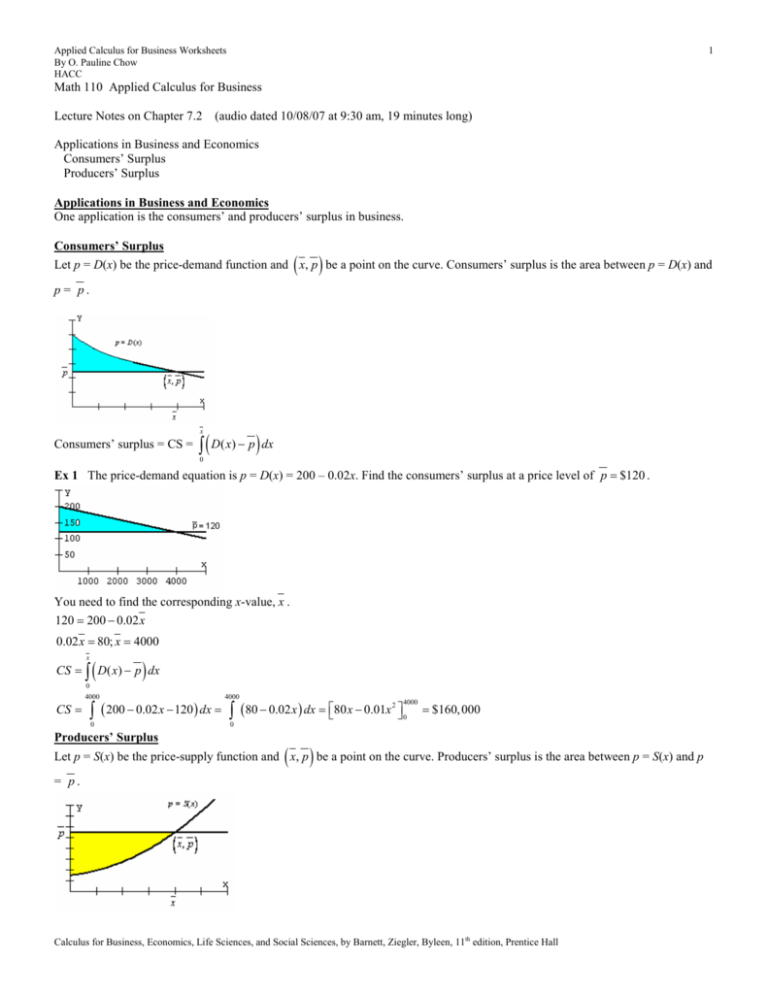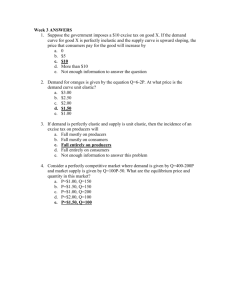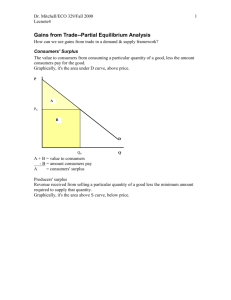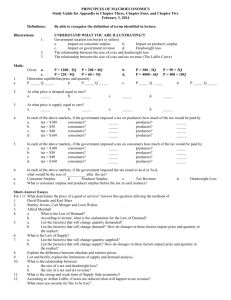∫ ∫ ∫ ∫
advertisement

Applied Calculus for Business Worksheets By O. Pauline Chow HACC 1 Math 110 Applied Calculus for Business Lecture Notes on Chapter 7.2 (audio dated 10/08/07 at 9:30 am, 19 minutes long) Applications in Business and Economics Consumers’ Surplus Producers’ Surplus Applications in Business and Economics One application is the consumers’ and producers’ surplus in business. Consumers’ Surplus ( ) Let p = D(x) be the price-demand function and x, p be a point on the curve. Consumers’ surplus is the area between p = D(x) and p = p. x Consumers’ surplus = CS = ∫ ( D( x) − p ) dx 0 Ex 1 The price-demand equation is p = D(x) = 200 – 0.02x. Find the consumers’ surplus at a price level of p = $120 . You need to find the corresponding x-value, x . 120 = 200 − 0.02 x 0.02 x = 80; x = 4000 x ( ) CS = ∫ D( x) − p dx 0 CS = 4000 4000 0 0 4000 2 ∫ ( 200 − 0.02 x − 120 ) dx = ∫ (80 − 0.02 x ) dx = 80 x − 0.01x 0 Producers’ Surplus = $160, 000 ( ) Let p = S(x) be the price-supply function and x, p be a point on the curve. Producers’ surplus is the area between p = S(x) and p = p. Calculus for Business, Economics, Life Sciences, and Social Sciences, by Barnett, Ziegler, Byleen, 11th edition, Prentice Hall Applied Calculus for Business Worksheets By O. Pauline Chow HACC 2 x Producers’ surplus = PS = ∫ ( p − S ( x) ) dx 0 Ex 2 The price-supply equation is p = S(x) = 15 + 0.1x + 0.003x2. Find the producers’ surplus at a price level of p = $55 . You need to find the corresponding x-value, x . 55 = 15 + 0.1x + 0.003 x 2 2 0.003x + 0.1x − 40 = 0 −0.1 ± 0.49 = 100 or − 133.3 0.006 x = 100 x= x ( ) PS = ∫ p − S ( x) dx 0 100 PS = 100 ∫ ( 55 − 15 − 0.1x − 0.003x ) dx = ∫ ( 40 − 0.1x − 0.003x ) dx = 40 x − 0.05x 2 2 0 2 100 − 0.001x 3 0 = $2500 0 Ex 3 Given: p = D(x) = 25 – 0.004x2, p = S(x) = 5 + 0.004x2. Find the consumers’ and producers’ surpluses. First you need to find the point(s) of intersection which is the same as the equilibrium point. 25 – 0.004x2 = 5 + 0.004x2 20 = 0.008x2 x2 = 2500, x = 50 p = 25 – 0.004(50)2 = 15 ( x, p ) = (50,15) 50 CS = ∫ ( 25 − 0.004 x 2 − 15 ) dx = 0 0.004 ∫ (10 − 0.004 x ) dx = 10 x − 3 x 2 3 0 50 PS = 50 50 50 0.004 ∫ (15 − 5 − 0.004 x ) dx = ∫ (10 − 0.004 x ) dx = 10 x − 3 x 2 0 2 0 = 333.3 ≈ 333.33 0 50 = 333.3 ≈ 333.33 3 0 Calculus for Business, Economics, Life Sciences, and Social Sciences, by Barnett, Ziegler, Byleen, 11th edition, Prentice Hall Applied Calculus for Business Worksheets By O. Pauline Chow HACC 3 Ex 4 Given: p = D(x) = 185e –0.005x, p = S(x) = 25e 0.005x . Find the consumers’ and producers’ surpluses. First you need to find the point(s) of intersection which is the same as the equilibrium point. 185e −0.005 x = 25e0.005 x 185 e0.005 x = = e0.005 x + 0.005 x 25 e −0.005 x 7.4 = e0.01x ln 7.4 = 0.01x ln 7.4 = 200.148 ≈ 200 0.01 p = 185e −0.005(200.148) = 68 x= ( x, p ) = (200, 68) 200 200 CS = ∫ (185e 0 −0.005 x 185 −0.005 x e − 68 ) dx = − 68 x −0.005 0 = −37000e −0.005 x − 68 x 200 200 0 = −37000e −1 − 13600 + 37000 ≈ 9788.46 200 25 0.005 x 0.005 x 0.005 x 200 ∫0 ( 68 − 25e ) dx = 68x − 0.005 e 0 = 68 x − 5000e 0 = 13600 − 5000e + 5000 ≈ 5008.59 PS = Calculus for Business, Economics, Life Sciences, and Social Sciences, by Barnett, Ziegler, Byleen, 11th edition, Prentice Hall







